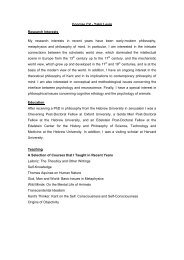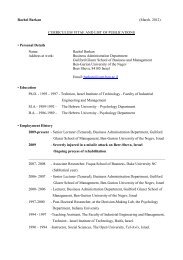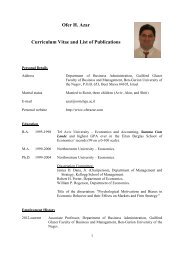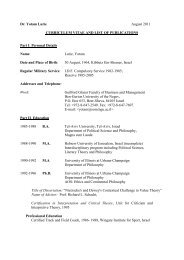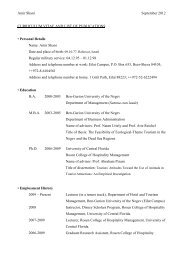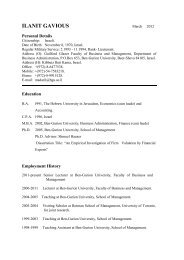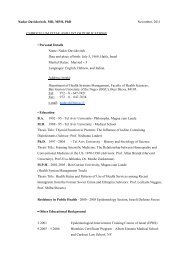- Page 1 and 2: Anglia Ruskin University "Self- Por
- Page 3 and 4: Chapter 4: The Language of Art 4.1
- Page 5 and 6: Chapter 12: Summary and conclusions
- Page 7 and 8: List A - Diagrams and Tables Part I
- Page 9 and 10: Number ILS. 1: ILS. 2: ILS. 3: ILS.
- Page 11 and 12: List C - Figures of the Findings Nu
- Page 13 and 14: Fig. 23: 6 Paintings - Black and Wh
- Page 15 and 16: Fig. 57(a, b, c): 18 Items - Detail
- Page 17 and 18: Abstract The research proposes a mo
- Page 19 and 20: diligent work. Sometimes, sick and
- Page 21: PART I INTRODUCTORY: THE 'SELF' AND
- Page 25 and 26: Artists who chose painting self - p
- Page 27 and 28: aise hidden entities from the inner
- Page 29 and 30: esearcher, leads this approach and
- Page 31 and 32: Introduction; Chapter 3 - Designing
- Page 33 and 34: definition of Hohenstein 'art knowl
- Page 35 and 36: individuals. This phenomenon appear
- Page 37 and 38: and it will be what the interpreter
- Page 39 and 40: treating the patient but as part of
- Page 41 and 42: taking place. This study researches
- Page 43 and 44: Chadwick 1998, 2001; West, 2004). T
- Page 45 and 46: self-portrait, therefore I investig
- Page 47 and 48: 2.5 Creation and Investigation 2.5.
- Page 49 and 50: Primary thought processes exert a d
- Page 51 and 52: I have chosen an approach that allo
- Page 53 and 54: 2. Keeping doing this consistently
- Page 55 and 56: Diagram 1: The Disciplines involved
- Page 57 and 58: through a work of art, about a work
- Page 59 and 60: 3. Subject investigates object (fil
- Page 61 and 62: 3.4.3 The Research Object In painti
- Page 63 and 64: 'What' is the methodology needed to
- Page 65 and 66: In this chapter: 4.1 Origins 4.2 Fo
- Page 67 and 68: that grants a tangible shape to fee
- Page 69 and 70: Extending this understanding of the
- Page 71 and 72: Mukarovsky (1983) explains that sur
- Page 73 and 74:
4.2.3 Single, Primary Artistic Mean
- Page 75 and 76:
Other single artistic means, omitte
- Page 77 and 78:
McNiff (1998), an art therapist, cr
- Page 79 and 80:
In this chapter: Chapter 5: METHODO
- Page 81 and 82:
My creative activity developed in a
- Page 83 and 84:
Dilthey is the most prominent repre
- Page 85 and 86:
5.2.3 Supplementary Research Approa
- Page 87 and 88:
designate the boundaries of time, p
- Page 89 and 90:
2. Meetings and conversations with
- Page 91 and 92:
Table 1: Data Classification into O
- Page 93 and 94:
5.4.2 Intertextuality Intertextuali
- Page 95 and 96:
need translocations and metaphors.
- Page 97 and 98:
Para-textuality - Table 2: The Comp
- Page 99 and 100:
5.5 Truth, Validity and Reliability
- Page 101 and 102:
5.5.3 Reliability and Validity The
- Page 103 and 104:
process. The limits of the research
- Page 105 and 106:
Is it appropriate for a researcher
- Page 107 and 108:
classified and managed. I discuss i
- Page 109 and 110:
PART Il THE INQUIRY: THE PORTRAIT A
- Page 111 and 112:
Diagram 8a (1): Style and Genre - G
- Page 113 and 114:
Diagram 8b (3): Visual Values - Org
- Page 115 and 116:
How the Findings (Paintings) are di
- Page 117 and 118:
In this chapter: 6.1 Super-Finding:
- Page 119 and 120:
3 1 99 2 4
- Page 121 and 122:
6.2 The Artist's 'Act of Choice' Th
- Page 123 and 124:
the researcher to identify these co
- Page 125 and 126:
people perceived the thundering and
- Page 127 and 128:
say that the artist chooses water a
- Page 129 and 130:
6.5 Extra-Textual Affinity - Conver
- Page 131 and 132:
Fig. 3: 4 Items - 'Object - Book' -
- Page 133 and 134:
(c) From Object to Installation - S
- Page 135 and 136:
115
- Page 137 and 138:
This installation was created from
- Page 139 and 140:
hundreds, and all these together cr
- Page 141 and 142:
1 1 3 121 2 2 Installation Exhibiti
- Page 143 and 144:
123
- Page 145 and 146:
Summary The study’s single 'case
- Page 147 and 148:
In this chapter: 7.1 Image and Writ
- Page 149 and 150:
3 1 129 2 4
- Page 151 and 152:
7.2 Image and Writing in Art The en
- Page 153 and 154:
When the artist was occupied with h
- Page 155 and 156:
(a) Encounter - "One on One, One ne
- Page 157 and 158:
Fig.8 (1) reinforces this for one e
- Page 159 and 160:
The random two sentences marked by
- Page 161 and 162:
These findings present several situ
- Page 163 and 164:
7.4.1 Dialogue - Texts Developing f
- Page 165 and 166:
7.5 Images with Handwriting text on
- Page 167 and 168:
. 1 2 147
- Page 169 and 170:
1 2 The researcher differentiates b
- Page 171 and 172:
5 1 9 2 6 10 In these images newspa
- Page 173 and 174:
Summary Ils 4: Image with Headings
- Page 175 and 176:
In this chapter: Introductory Summa
- Page 177 and 178:
Introductory Summary Having in Chap
- Page 179 and 180:
1 13 5 2 6 159 3 15 7 4
- Page 181 and 182:
1 4 1 2 5 161 2 3 6
- Page 183 and 184:
enewal. Netzer (2004) points at the
- Page 185 and 186:
The strategy of the artist to keep
- Page 187 and 188:
1 1 1 2 2 167 3 3
- Page 189 and 190:
The penetration of this colour symb
- Page 191 and 192:
The colours infiltrating the black
- Page 193 and 194:
Fig. 27, shows the use of a variety
- Page 195 and 196:
The image of the bird that appeared
- Page 197 and 198:
8.4.1 Findings Kandinsky considered
- Page 199 and 200:
1 3 1 1 179 2 4 3 2
- Page 201 and 202:
8.5 Dominant Colour - Red ILS. 12:
- Page 203 and 204:
1 5 13 9 2 14 3 6 7 10 183 15 11 4
- Page 205 and 206:
8.5.2 Red - Symbol and Significance
- Page 207 and 208:
8.6.1 The Findings Fig. 42: 7 Paint
- Page 209 and 210:
8.6.2. Yellow - Symbol and signific
- Page 211 and 212:
Regarding the dialogue between colo
- Page 213 and 214:
sounds. The two colours polarity of
- Page 215 and 216:
In the encounter of the elementary
- Page 217 and 218:
Red & Green 1 3 1 2 5 2 197 1 3 6 4
- Page 219 and 220:
is expressed in a number of finding
- Page 221 and 222:
In this chapter: 9.1 Drawing in Cha
- Page 223 and 224:
The use of this technique and these
- Page 225 and 226:
The dialogue between line and Tone
- Page 227 and 228:
8 Line encounters Tone of Colour in
- Page 229 and 230:
1 5 1 2 209 4
- Page 231 and 232:
lurred everything. I painted thin,
- Page 233 and 234:
A repeating pattern is a form of ex
- Page 235 and 236:
At first glance such patterns (Fig.
- Page 237 and 238:
The technique of aquarelle is based
- Page 239 and 240:
This technique introduces the subje
- Page 241 and 242:
The terms 'collage' and 'assemblage
- Page 243 and 244:
When the artist chooses a book as t
- Page 245 and 246:
225
- Page 247 and 248:
Chapter 10: STRUCTURE AND ORGANISAT
- Page 249 and 250:
10.1.1 Findings and Interpretation
- Page 251 and 252:
Fig. 75 (a, b): 6 Paintings - Part
- Page 253 and 254:
This finding shows a partial face.
- Page 255 and 256:
9 8 235 10
- Page 257 and 258:
Here, disassembly takes another for
- Page 259 and 260:
Zemach (1992) summarises it thus: "
- Page 261 and 262:
SUMMARY TO THE INQUIRY 1 The chapte
- Page 263 and 264:
I did not look for one absolute, un
- Page 265 and 266:
Foreword This research study has tw
- Page 267 and 268:
Diag.11 The 'Chain of Observations'
- Page 269 and 270:
11.1 Split 1: Unification and Separ
- Page 271 and 272:
The split that occurs at the 'mirro
- Page 273 and 274:
hint or as Lacan (in Vanier, 2003)
- Page 275 and 276:
The 'subject' is the person facing
- Page 277 and 278:
profane ('Book Object', Readymade',
- Page 279 and 280:
Lacan (in Vanier, 2003) defines it
- Page 281 and 282:
Diag. 14: Split 3: ' Ego' and 'Self
- Page 283 and 284:
'Ego' and 'self' join and collabora
- Page 285 and 286:
history in a continuous process of
- Page 287 and 288:
differentiates between the individu
- Page 289 and 290:
11.7 Ego Designs a Portrait-Myth Ar
- Page 291 and 292:
Chapter 12: THESIS SUMMARY Conclusi
- Page 293 and 294:
4. My research broadens the concept
- Page 295 and 296:
Chapter 13: IMPLEMENTATION AND VALI
- Page 297 and 298:
interdisciplinary intersubjective,
- Page 299 and 300:
As a creator and researcher I went
- Page 301 and 302:
the potential of the 'ego'. In my r
- Page 303 and 304:
13.2.2 The 'Artistic - Activity' Th
- Page 305 and 306:
In this way he gives meaning to the
- Page 307 and 308:
The participants in the workshop ha
- Page 309 and 310:
the human being (Frankl, 1981). The
- Page 311 and 312:
create works of art of universal va
- Page 313 and 314:
My journals divulge that there were
- Page 315 and 316:
During the course of the research I
- Page 317 and 318:
References Abraham, A. (1989) The V
- Page 319 and 320:
At: http://www.qualitative-research
- Page 321 and 322:
Diamant, A. ( 2005) The Red Tent. (
- Page 323 and 324:
Environment Journal. (Vol.5 22-24).
- Page 325 and 326:
Klein, M. (1975) The Writings of Me
- Page 327 and 328:
McNiff, S. (1998) Art-Based Researc
- Page 329 and 330:
Reinhart, T. (2000) From Cubism to
- Page 331 and 332:
Shoshani, A. (2002) Experience and
- Page 333 and 334:
Van Gogh, V. (1992) Letters to Theo
- Page 335 and 336:
App. No List D - Table of Appendice
- Page 337 and 338:
2. To develop a method of analysis
- Page 339 and 340:
The complete process has been docum
- Page 341 and 342:
The research to examine the hidden
- Page 343 and 344:
paintbrush for a painting that will
- Page 345 and 346:
The research examines their signifi
- Page 347 and 348:
This sentence can serve as a headin
- Page 349 and 350:
1 2 Again, Dadaism peeks out of the
- Page 351 and 352:
The words and sentences randomly ma
- Page 353 and 354:
And the fisherman’s heart beats.
- Page 355 and 356:
formative struggle takes place betw
- Page 357 and 358:
Fig. 13(b): - 1 item - Handwriting
- Page 359 and 360:
is hinting about reflection, self o
- Page 361 and 362:
Here, too, the curled and uniform w
- Page 363 and 364:
directing decision. Naturally, some
- Page 365 and 366:
8 1 3 6 9 30 4 7 2 5
- Page 367 and 368:
Fig. 12(c): 1 Item - Letters and Bi
- Page 369 and 370:
Thus, handwriting has led the reade
- Page 371 and 372:
ecomes a work of art about self-por
- Page 373 and 374:
Here too the artist uses greyish: n
- Page 375 and 376:
According to ancient beliefs, a lun
- Page 377 and 378:
Appendix 3 8.1 Black and White PART
- Page 379 and 380:
But maybe a lot of power is hiding
- Page 381 and 382:
suddenly, I understand that these a
- Page 383 and 384:
The artist has discussed the issue
- Page 385 and 386:
everything. Nothing interests me [
- Page 387 and 388:
he came near the sun and the water
- Page 389 and 390:
Lips are sensual organs that transm
- Page 391 and 392:
In her journal the artist writes: "
- Page 393 and 394:
Fig. 40 combines two strong symbols
- Page 395 and 396:
Athena `represent "independence and
- Page 397 and 398:
this work through. The yellow expre
- Page 399 and 400:
. Fig. 36: 1 Detail - Finding from
- Page 401 and 402:
5 The dialogue sharpens and now the
- Page 403 and 404:
13 12 1 71 14
- Page 405 and 406:
The word leaf appears in different
- Page 407 and 408:
constrictions and work freely and t
- Page 409 and 410:
(A2 (a) 8.8.04). On both sides of t
- Page 411 and 412:
parts (images, shapes, parts of the
- Page 413 and 414:
16 Fig. 55 shows some of the portra
- Page 415 and 416:
The assumption is that when the art
- Page 417 and 418:
drawing process, as part of the act
- Page 419 and 420:
A phenomenon of an eye poking out a
- Page 421 and 422:
Avrahami leads and guides: “As op
- Page 423 and 424:
The study pointed at the situations
- Page 425 and 426:
Elsewhere the study represents each
- Page 427 and 428:
dipped into the 'dying lake', dived
- Page 429 and 430:
of this study ― a core and key fi
- Page 431 and 432:
Fig. 59 (4) depicts a figure reflec
- Page 433 and 434:
101
- Page 435 and 436:
Appendix 5 Chapter 10: ORGANISATION
- Page 437 and 438:
The above three findings describe a
- Page 439 and 440:
In an analogy to Jung's approach (1
- Page 441 and 442:
The findings from group 2D - from t
- Page 443 and 444:
Fig. 83: 4 Paintings - Dismantling
- Page 445 and 446:
Fig. 85: 6 Paintings - Transformati
- Page 447 and 448:
Fig. 87: 6 Paintings -Transformatio
- Page 449 and 450:
Glossary 1 Act of Separation: A cri
- Page 451:
Single, Primary Formative artistic



